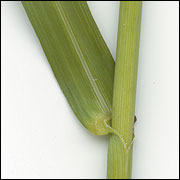Smooth bromegrass (Bromus inermis Leyss.)
Cool-season grasses
Smooth bromegrass is a cool-season grass often used for hay, pasture, silage, green chop and erosion control. Its responsiveness to nitrogen fertilizer, ability to grow well with legumes, good drought-tolerance and excellent overwintering capacity make it important throughout the northern United States. Although Missouri is on the southern edge of its range, smooth bromegrass still provides a valuable resource for many farmers. Smooth bromegrass can easily suffer from overgrazing and does not regrow as well as other cool-season grasses. It is important to avoid clipping or grazing smooth bromegrass shorter than 4 inches. Fields clipped or grazed shorter than this do not regrow well or persist very long.
 Smooth bromegrass
Smooth bromegrass
 Yield distribution of smooth bromegrass in Missouri.
Yield distribution of smooth bromegrass in Missouri.
- Origin: Eastern Europe
- Adaptation to Missouri: Especially good in northern Missouri
- Growth habit: Rhizomatous, sod-forming, perennial.
- Blade: Rolled in bud, flat and narrow, tapers to tip, smooth on top, distinct “W” at midpoint of leaf, dull on lower side, margins smooth to rough.
- Sheath: Round, smooth, closed near top, lower sheath pubescent.
- Ligule: Membranous, truncate to rounded, 1/10 inch.
- Auricles: Absent.
- Seed head: Open drooping panicle, often one-sided, spreading.
- Fertilization: 30 to 40 lb N/acre following the first grazing or harvest in spring. In addition, apply 40 to 60 lb N/acre in mid-August for fall pasture. Phosphorus and potassium as needed.
- Timing of production: 80 percent of growth before June 15.
- When to begin grazing: When the grass reaches 8 inches in height.
- When to cut for hay: Early heading stage, typically about mid-May.
- Lowest cutting or grazing height: 4 inches
- Fall management: Light grazing or haying possible through October if a 6-inch stubble is left for winter.


